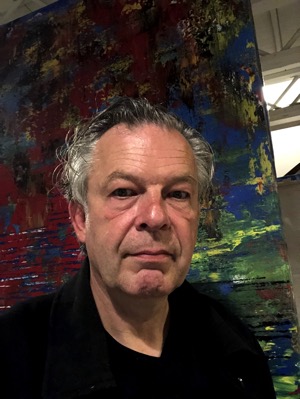

Artistic Journey
John Bernard is a figure of intrigue and depth in the contemporary art scene, a German-born artist whose pursuits have spanned the realms of science, entrepreneurship, and most pivotally, abstract art. Residing now in California, Bernard’s journey is a chronicle of rigorous exploration and profound personal evolution, marked by a relentless quest for an artistic voice that truly resonates with his diverse experiences.
Bernard’s initial foray into the arts commenced in Paris, a city synonymous with artistic revolution and historical depth. Studying the art of Salvador Dali and Pablo Picasso, Bernard was exposed to a spectrum of artistic philosophies and techniques. These experiences laid the foundational stones of his artistic ideology, steeped in the traditions of classical modernism but destined for transformation.
Originally a practitioner of classical oil painting and drawing, Bernard’s early works were characterized by a strict adherence to the representational form. These pieces, meticulous and evocative, were crafted with the precision of a trained draftsman—yet within them simmered a burgeoning curiosity for more liberated forms of expression. Photography, another discipline he explored, served as a pivotal medium through this transition. It allowed Bernard to capture reality with an immediacy and abstraction that painting at the time did not afford him.
However, the true metamorphosis in Bernard’s artistic career came with his deliberate pivot to abstract painting. This shift was not impulsive but a result of years of contemplation and experimentation. Abstract art, with its emphasis on form, color, and texture over representational accuracy, offered Bernard the freedom he sought—from the constraints of visible forms and the expectations tethered to them. His philosophy on abstraction grew clearer with each canvas, encapsulated by his belief that “A person can only really enjoy abstract art when stopping to try to see anything learned or preoccupied in the work. When the work can be enjoyed just as she is.”
In California, Bernard’s studio became a sanctuary where these abstract ideologies were nurtured into vibrant canvases, marked by an orchestration of color and a deliberate chaos of forms. His compositions, often large-scale, invite viewers to lose themselves in the visual landscapes he creates—landscapes that challenge the eye to move beyond familiar interpretations and to engage with emotion and introspection.
Despite his significant artistic achievements, Bernard has chosen to remain an enigma, presenting his art under a pseudonym. This decision stems from a nuanced understanding of the biases prevalent in scientific and business domains—fields in which he is also deeply embedded as a nuclear physicist and a tech entrepreneur. By compartmentalizing his identities, Bernard protects his artistic practice from being overshadowed by his scientific accomplishments, ensuring that each can be appreciated in its own right.
Bernard’s work has inadvertently drawn comparisons to that of Gerhard Richter, another master of German abstract painting. Though both artists share a profound commitment to abstraction, their approaches and inspirations are uniquely their own. Bernard’s path to abstraction was self-forged, inspired by his diverse experiences and personal revelations rather than the influence of his contemporaries. The similarities between him and Richter, while aesthetically apparent, are coincidental—both artists see abstract art as a vehicle for exploring the intrinsic beauty and chaos of visual elements.
Expanding further on his artistic philosophy, Bernard often discusses the concept of abstraction as a form of ultimate freedom—a space where the artist and viewer alike can encounter pure experience unbounded by preconceived notions or societal labels. This philosophy not only informs his artistic output but also permeates his public discussions and writings, which are peppered with insights drawn from his scientific background.
As John Bernard continues to evolve both as an artist and a thinker, his works serve not only as artifacts of his personal journey but also as invitations to the viewer to reconsider the role of art in society. They prompt a dialogue on the value of abstraction, not just as an aesthetic choice but as a profound mode of human expression—connecting the seen with the unseen, the known with the mysterious.
Bernard’s artistic evolution, his philosophical stances, the dialogues, and his works inspire and provide a richer, more textured understanding of this multifaceted art and the complexities of navigating multiple worlds.


